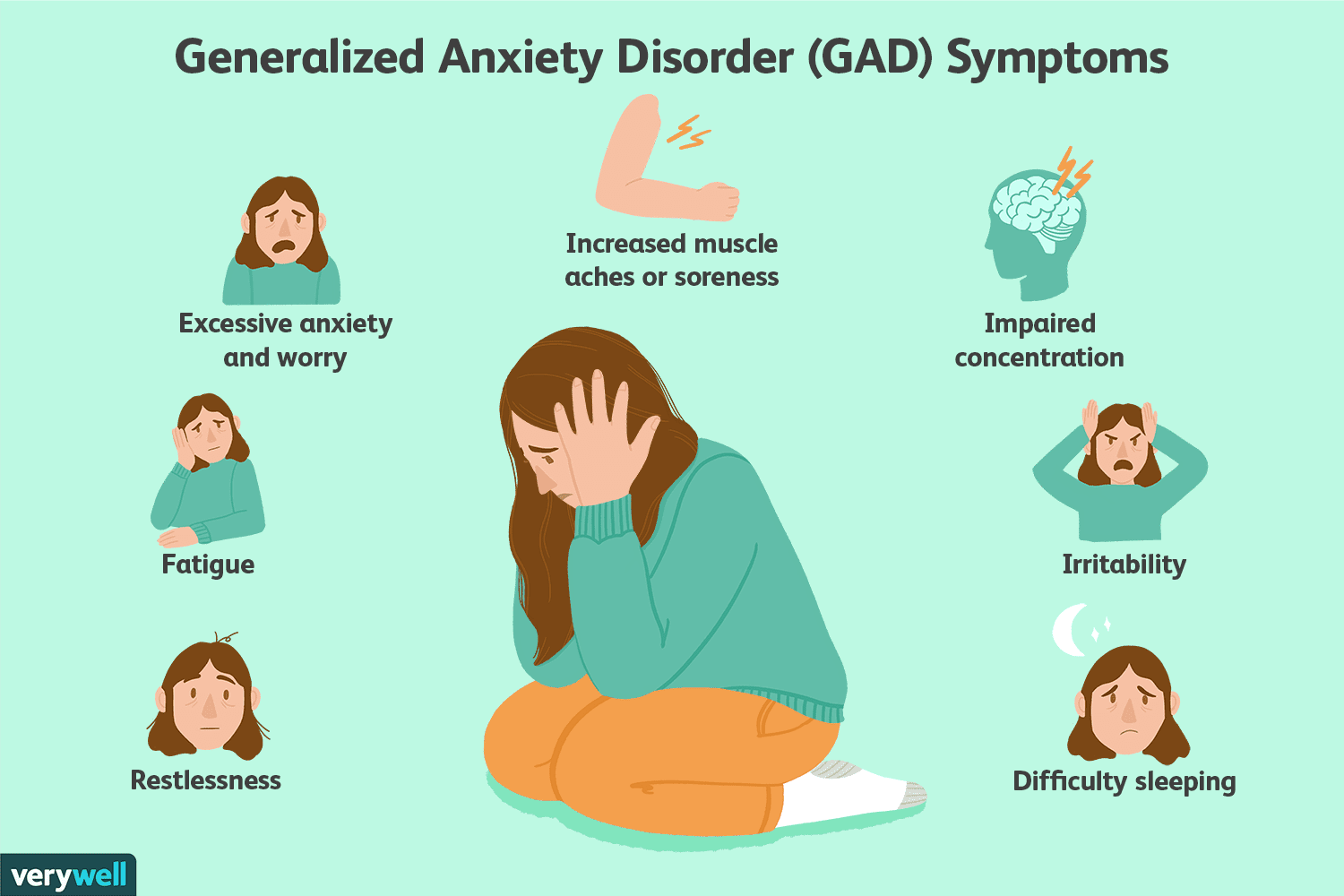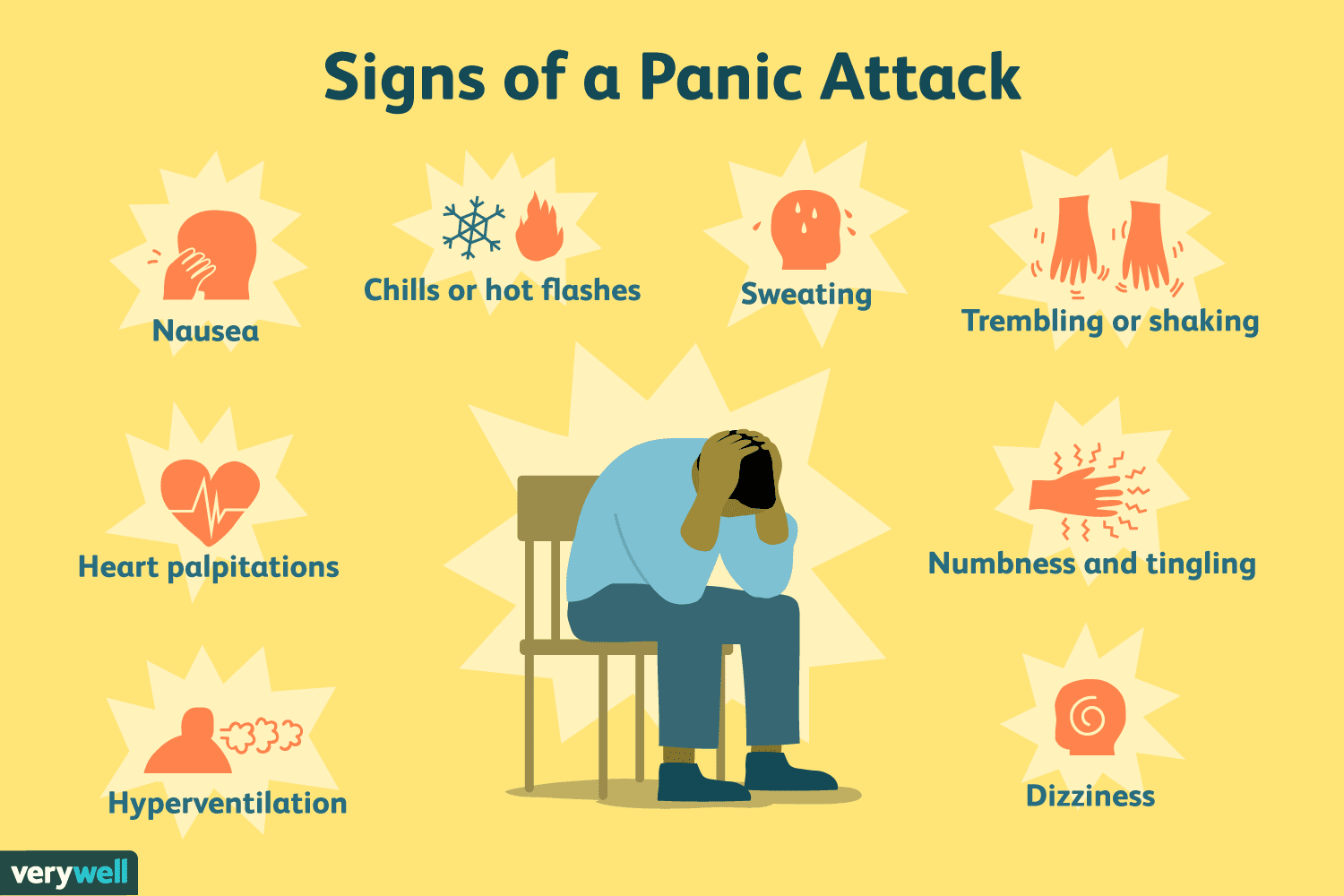Anxiety Disorders
Social Anxiety Disorder
Key Features. People with this disorder experience excessive fear or anxiety of social situations in which there is a possibility (real or perceived) of humiliation, embarrassment, or rejection. Although the official diagnostic criteria focus on several cognitive symptoms and one behavioral symptom (avoidance of social situations), it is also common to experience physical symptoms (illustrated in the infographic, below).

Prevalence. The 12-month prevalence is approximately 7%. Children and adolescents have rates similar to those of adults. Prevalence rates have been found to decrease with age. Females are about twice as likely as males to be affected.
Diagnostic Criteria. If you have been experiencing the following symptoms for at least 6 months, you may be suffering from Social Anxiety Disorder:
- Intense fear or anxiety of social situations in which there is a possibility that you may be scrutinized by others (e.g., talking to others, meeting unfamiliar people, being observed eating or drinking, giving a speech or otherwise performing in front of others), and may be judged by them as anxious, weak, crazy, stupid, boring, intimidating, dirty, or unlikable
- You fear that you will act or appear in a certain way or show anxiety symptoms (e.g., blushing, trembling, sweating, stumbling over your words, or staring), which will cause humiliation or embarrassment and will lead others to reject you or be offended by you (with the latter being a less common fear)
- Social situations almost always cause you fear or anxiety
- The degree and type of your fear and anxiety may vary across different occasions (e.g., a panic attack vs. anticipatory anxiety)
- Your anticipatory anxiety may occur far in advance of upcoming situations (e.g., you worry for weeks or days before a scheduled social event)
- You often avoid the feared social situations, or you endure them with intense fear or anxiety
- The fear or anxiety you are experiencing is out of proportion to the actual risk of being negatively evaluated or to the consequences of such negative evaluation
- The fear, anxiety, or avoidance causes you significant distress or impairment in social, occupational, or other important areas of functioning
Associated Features. Although the diagnosis should be made only if the official diagnostic criteria are met, the DSM-5 also lists associated features.
- In social situations, you may…
- Be inadequately assertive or excessively submissive or, less commonly, try to completely control a conversation with someone
- Have rigid body posture, inadequate eye contact, or speak in a very soft voice
- Be withdrawn and disclose very little about yourself
- You may also…
- Seek out jobs that require no or minimal social contact
- Live at home longer or delay having a family
- Self-medicate with substances, such as drinking before going to a social event
Generalized Anxiety Disorder
Key Features. Excessive anxiety and worry across a number of situations. Physical symptoms are also common.

Prevalence. The 12-month prevalence is approximately 2.9% among adults and 0.9% among adolescents. The prevalence peaks in middle age and declines in later years. Females are twice as likely as males to be affected.
How GAD Differs From Nonclinical Anxiety & Worry. Since almost everyone has been anxious or worried about something at one time or another, what makes GAD different?
First, GAD worries are excessive, perceived as unmanageable in the long term, and interfere significantly with overall functioning.
Second, GAD worries are more pervasive (involve a broad range of life circumstances), forceful, and distressing. They also persist longer and often occur without a specific precipitant.
Third, GAD is much more likely to cause physical symptoms, as seen below in the diagnostic criterion #3 (a, b, and e). In addition, there may be muscle aches or soreness, trembling, twitching, and feeling shaky. Many individuals with GAD also experience sweating, nausea, diarrhea, IBS, headaches, and an exaggerated startle response.
Fourth, GAD causes moderate to severe disability. In the U.S., the diagnosis of GAD accounts for 110 million disability days per year. GAD impairs one’s ability to do things quickly and efficiently, whether at home or at work. It takes time and energy away from tasks and life in general. For parents with GAD, it has been found that excessive worrying may keep them from encouraging confidence in their children.
Diagnostic Criteria. If you have been experiencing the following symptoms for at least 6 months (more days than not), you may be suffering from GAD:
- Excessive anxiety and worry about a number of events or activities, with the intensity, duration, or frequency of the anxiety and worry being out of proportion to the actual likelihood or impact of the anticipated event
- You find it difficult to control the worry and to keep the worrisome thoughts from interfering with attention to tasks at hand
- You worry about a large range of everyday, routine life circumstances, such as your job, health, finances, the health and safety of family members, or minor matters (e.g., household chores)
- You may not necessarily worry about everything simultaneously but shift the focus of your distress from one concern to another
- Such worries are excessive, pervasive, pronounced, last longer, do not have a specific antecedent, often cause physical symptoms, and typically have a significant negative impact on your functioning
- You have been experiencing at least 3 of the following 6 symptoms (with most of
them present more days than not for the past 6 months):- Restlessness or feeling keyed up or on edge
- Becoming easily fatigued
- Difficulty concentrating or mind going blank
- Irritability
- Muscle tension
- Difficulty falling or staying asleep, or restless, unsatisfying sleep
- The anxiety, worry, or physical symptoms cause significant distress or impairment in social, occupational, or other important areas of functioning
Development & Course. Although the median age of onset for GAD is 30 years, which is later than for other anxiety disorders, the onset can occur significantly earlier or later than the median. GAD tends to be chronic and waxes and wanes across the lifespan, fluctuating between clinical and subclinical. The main difference across age groups is in the content of worry (e.g., children and teens tend to worry more about school and athletic performance).
It is rare for someone who suffers from GAD to become completely symptom free. In addition, those with GAD are likely to have other anxiety disorders at one time or another, as well as unipolar depression.
Panic Disorder
Key Features. Recurrent and unexpected panic attacks. The frequency and severity of such attacks vary widely. The symptoms are both physical and cognitive.

Prevalence. The 12-month prevalence is approximately 2%-3% in adults and adolescents (for children, it is less than 0.4%). Females are twice as likely as males to be affected. The rates gradually increase during adolescence, particularly in females, peak during adulthood, and then decline in older age.
Diagnostic Criteria. If you have been experiencing the following physical and cognitive symptoms, you may be suffering from Panic Disorder:
- Recurrent unexpected panic attacks experienced as an abrupt surge of intense fear or discomfort that peaks within minutes. At least 4 of the following symptoms must occur:
- Palpitations, pounding heart, or accelerated heart rate
- Sweating
- Trembling or shaking
- Sensations of shortness of breath or smothering
- Feelings of choking
- Chest pain or discomfort
- Nausea or abdominal distress
- Feeling dizzy, unsteady, light-headed, or faint
- Chills or heat sensations
- Numbness or tingling sensations (paresthesias)
- Derealization (feelings of unreality) or depersonalization (being detached from oneself)
- Fear of losing control or “going crazy”
- Fear of dying
- At least one of these attacks has been followed by at least 1 month of one or both of the following:
- Persistent concern or worry about additional panic attacks or their consequences
- A significant change in behavior in order to minimize or avoid future panic attacks (e.g., avoiding exercise or unfamiliar situations, restricting usual daily activities such as not leaving home or not using public transportation)
Frequency. It is possible to have one attack per week for months at a time, or short bursts of daily attacks separated by weeks or months without any attacks or with less frequent attacks (e.g., two per month) over many years.
Severity. It is possible to have both full-symptom (4 or more) and limited-symptom (fewer than 4) attacks. The number and type of panic attack symptoms frequently differ from one panic attack to the next.
Risk Factors for each disorder are presented below, in the form of an overview table, since some of the factors appear in more than one anxiety disorder.
| Risk Factors | SOCIAL ANXIETY DISORDER | GENERALIZED ANXIETY DISORDER (GAD) | PANIC DISORDER |
|---|---|---|---|
| Temperamental |
|
|
|
| Environmental |
|
|
|
| Genetic and Phisiological |
|
|
|
*Neuroticism refers to one of the personality traits included in the Five-Factor Model, which is the most widely accepted theory of personality to date.
NOTE: Up until the publication of the DSM-5 in 2013, the DSM-IV-TR classification of Anxiety Disorders included several more disorders, among them PTSD and Acute Stress Disorder. In the DSM-5, these two disorders are now categorized under Trauma- and Stressor-Related Disorders. Anxiety and fear remain important features of this group of disorders. However, the authors of the DSM-5 recognized that the predominant symptoms in some individuals exposed to a traumatic or highly stressful event are not anxiety-based. Instead, they experience symptoms that have more to do with dysphoria, externalized aggression, dissociation, or anhedonia (an overall inability to experience pleasure from or have interest in previously enjoyed activities).
Content based in part on the following two public domain sources:
- American Psychiatric Association: Diagnostic and Statistical Manual of Mental Disorders, Fifth Edition. Arlington, VA, American Psychiatric Association, 2013
- National Institute of Mental Health publications
